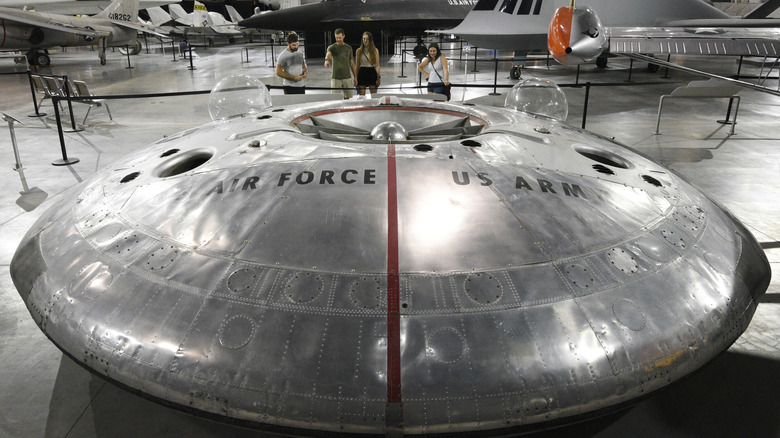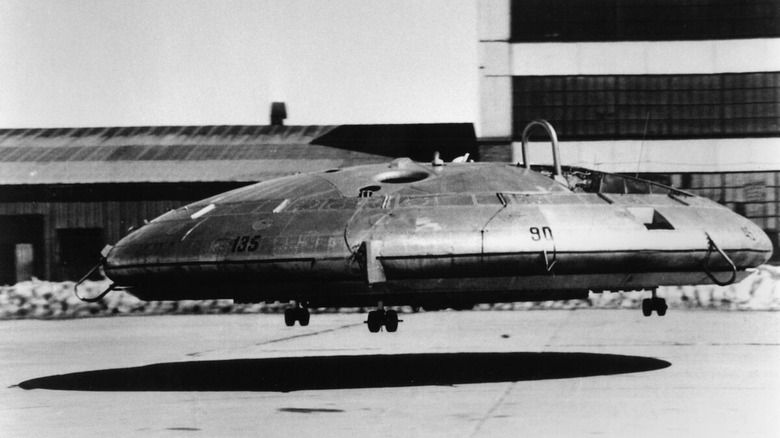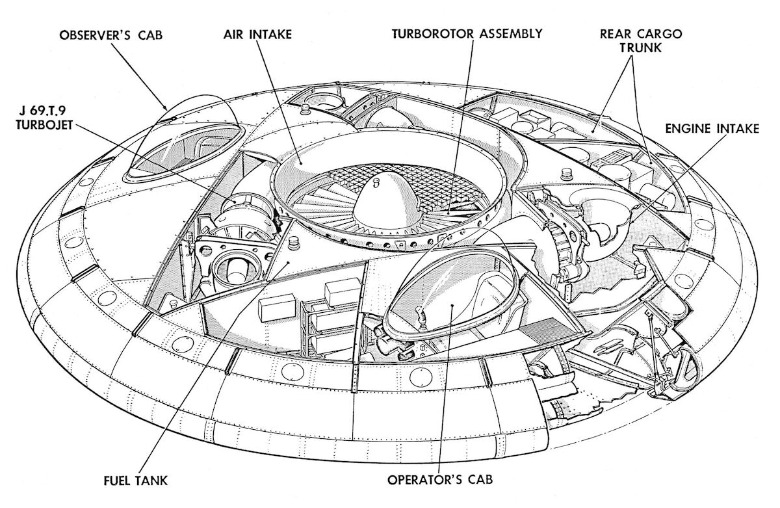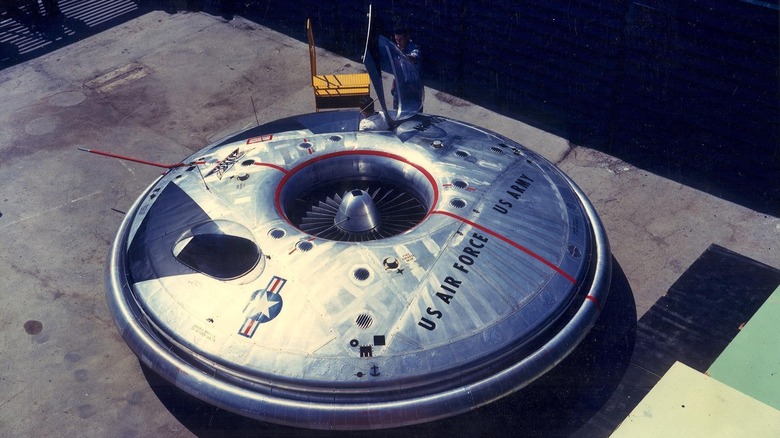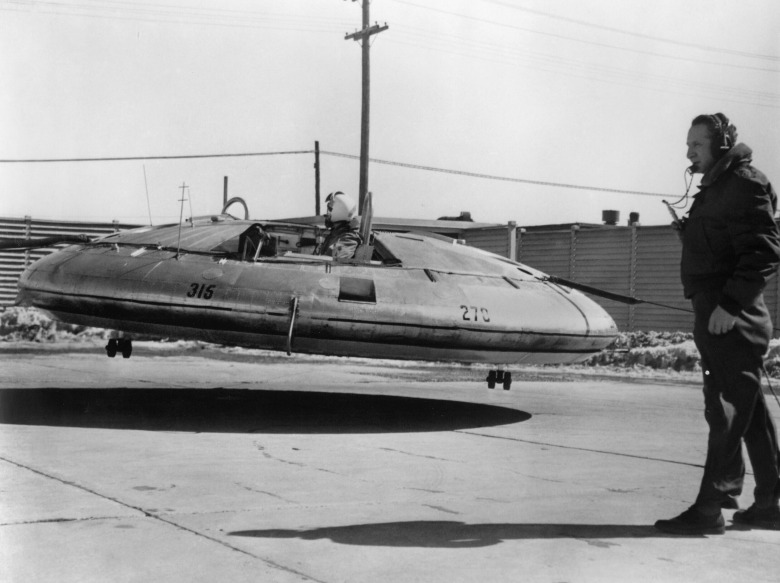The Avrocar Was The Real Flying Saucer Of The 1950s
Unidentified flying objects (UFOs) or flying saucers became a cultural obsession since amateur pilot Kenneth Arnold reported sightings of flashing bright lights around the skies of Mineral, Washington, on June 24, 1957. In a report by The Atlantic, Arnold claimed the bizarre flying objects flew "on a single horizontal plane" and "weaved from side-to-side, occasionally flipping, banking, and darting" above the Cascade Mountains. News of the incident broke out on June 25, and Arnold told reporters that what he saw moved "like a saucer if you skip it across the water," and the world was never the same again.
Before Arnold's UFO sightings, there were previous reports of flying phenomena as early as 1947 in Richmond, Virginia. According to the Report on the UFO Wave of 1947 by Ted Bloecher (released in 1967), U.S. government meteorologist Walter A. Minczewski and his staff saw a silver, ellipsoidal object flying below their pibal balloon at 15,000 feet. And on May 17, 1957 (about six weeks before Arnold's sighting), Oklahoma-based businessman and private pilot Byron Savage saw a shiny, perfectly round, and flat object flying at 10,000 feet and "made no noise."
Unbeknownst to Arnold, Minczewski, Savage, and most of the rest of the civilized world, the U.S. government worked on an aircraft called Avrocar in the early 1950s. The VZ-9AV Avrocar resembles a real-life flying saucer with vertical takeoff and landing (VTOL) capabilities and can rush to supersonic speeds, perfectly depicting a UFO's shape and flying patterns.
Avro Canada VZ-9AV Avrocar: Secret UFO Project
The VZ-9AV Avrocar ("V.Z." for "experimental vertical flight, "9" for the ninth concept proposal, and "A.V." for Avro, according to the USAF National Museum) was the creation of British designer John "Jack" Frost. Frost came to Avro Canada in 1947 after designing the DH-100 Vampire, DH-103 Hornet, and the quirky DH-108 Swallow for the U.K.'s Havilland Aircraft Company, said History Net.
Frost headed the Special Projects Group at Avro. His team developed the CF-100 Canuck, the first and only mass-produced Canadian long-range jet fighter and the most successful aircraft project in the Canadian aviation industry. But after World War II, Frost came up with ideas for VTOL aircraft that wouldn't need takeoff or landing strips. The Canadian government initially funded the project in 1952 but changed its mind immediately when the project became too costly.
In 1953, Frost invited an entourage of American defense experts to the Avro Special Projects Hangar to see first-hand the initial batch of secret models, drawings, and mockups of VTOL aircraft. History Net adds the U.S. Air Force was so impressed that they issued a handsome $750,000 contract to develop VTOL airplanes. More government funding came in 1957, and Frost continued development with funding from the U.S. Army and U.S. Air Force.
The Flying Jeep
Frost abandoned his early VTOL prototypes and built a scaled-down VTOL prototype he officially called the Avrocar in 1958. The Avrocar prototype was an aluminum disk that was 18 feet wide and 3½ feet tall. Inside were three Continental J69-T-9 jet engines driving a 124-blade turbo rotor in the center, directing the thurst downward to create a "ground effect" or cushion of air and fly at low altitudes. In turn, the thurst could lead to the rear of the disk to gain speed. The U.S. Army was interested in a "flying jeep" that could hover above the ground and transport a 1,000-pound payload for 25 miles, adds History Net. However, the U.S. Air Force wanted Avrocar to hover below the enemy radar and accelerate to supersonic speeds.
Things went south as scale models of the Avrocar entered testing at Wright-Patterson air force base in Ohio. According to the National Museum of the United States Air Force (NMUSAF), the air cushion under the Avrocar would become unstable after the vehicle lifted a few feet off the ground, and it was incapable of reaching supersonic speeds. NASA also tested the first Avrocar prototype at the Ames Research Center in California. Wind tunnel tests suggest Avrocar was "aerodynamically unstable" and "had insufficient high-speed flight control."
The second Avrocar prototype could hover three feet off the ground while reaching a 35 mph max speed. Still, it was "highly unstable" and "displayed uncontrollable pitch and roll motions" that Avro engineers described as "hubcapping." All efforts to cure the "hubcapping" failed, and the U.S. government abandoned the project in December 1961. The first Avrocar prototype (serial number 58-7055) is currently on display at the NMUSAF, while the second Avrocar is at the U.S. Army Transportation Museum at Fort Eustis, Virginia.
